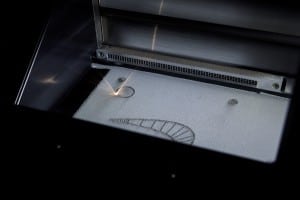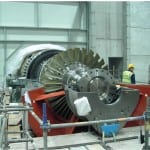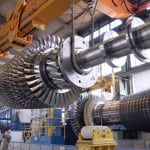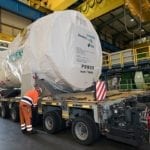Sometime around the end of Wednesday, April 27, at Siemens’ century-old factory in Berlin, employees will stop to celebrate the shipment of their 1,000th in-house-produced gas turbine.
Though Siemens has become one of the dominant, high-power gas turbine manufacturers worldwide, its Berlin shop is the only one that can build all the turbines in the company’s catalogue. The Huttenstrasse plant is also the center of the company’s research and development wing. Now equipped with a 3D metal selective laser printer, the company is using cutting-edge technology to push ever-larger load and physical limits.
During a plant tour for international media, we were able to observe the newest steam turbine units under construction, including the 1,000th gas turbine, a 300-MW SGT5-4000F scheduled for shipment to a Qatar power station. Qatar is just one of 60 nations the Berlin plant has shipped to. (To protect trade secrets, no photography was allowed on the tour.)
Workers at the Huttenstrasse plant are credited with fabricating the world’s largest and most powerful gas turbine to date, the SGT5-8000H, now in operation at the Fortuna gas plant in Dusseldorf, Germany. That plant holds three world records already: for electrical output from one unit, at over 600 MW; for overall net combined cycle efficiency of over 61%; and for overall efficiency for natural gas and steam usage at over 85%, including the use of steam for district heating.
Historic Turbine Plant
Established in 1904 as a trolley factory on the outskirts of Berlin, today’s Huttenstrasse plant produces the full catalog of Siemens gas turbines, with capacity ratings ranging from 113 MW to 400 MW. Sprawling over more than 130,000 square meters, the plant has approximately 3,700 employees and 270 apprentices. Siemens has a large footprint in Berlin, as this is one of five associated facilities in the area.
The original factory building, once owned by Siemens predecessor AEG, is where much of the turbine manufacturing happens. This cavernous architectural landmark resembles the Eiffel Tower in its use of steel beams, and somehow survived World War II’s destruction mostly in intact.
It wasn’t until 1972 that the plant shipped its first gas turbine for a power plant, a 62.5-MW ESTA 1 unit. In 1977, Siemens consolidated all its holdings of AEG, and in 1998 it purchased the power plant business unit of Westinghouse as well. A decade later, in 2007, Siemens delivered its first SGT5-8000H turbine to the German electricity producer E.ON. At the time it was the world’s largest and most powerful gas turbine. Following this success, Siemens invested over 42 million euros to enlarge the manufacturing hall so it could build more gas turbine blades in 2009. In 2010, the company’s newest facility, the Clean Energy Center in the Ludwigsfelde quarter of Berlin, opened.
Another record was set in 2011 with the beginning of energy production at the Ulrich Hartmann combined cycle power plant, formerly known as Irsching 4 (a 2011 POWER Top Plant winner), by E.ON again. This plant is rated at 60.75% efficiency. That same year, after a 30 million euro investment, Siemens opened a new test lab and drilling station in Berlin, the largest in Europe to date.
Also in 2011, Siemens rolled out its global footprint strategy with the dedication of fabrication centers in Charlotte, N.C.; St. Petersburg, Russia; and Saudi Arabia—though employees at the Berlin center proudly remind visitors that theirs is the only factory where all the turbines can be constructed.
In 2012, Siemens began shipping gas turbines via a new roll-on/roll-off ramp and facility at the Charlottenburger Canal in Berlin, allowing easier shipment of turbines to the port of Hamburg and to the rest of the world. In 2014, Siemens entered into an agreement to help construct the “Fortuna” combined cycle power plant unit in Dusseldorf.
Producing for Power Plants Worldwide
The main products of the Huttenstrasse factory are the 50 Hz and 60 Hz turbine units, including the SGT5-8000H, which at 400 MW are among the largest in the world. Huttenstrasse also produces SGT5-4000F (307 MW) and SGT5-2000E (187 MW) units. Both the 2000 and 8000 class units are scaled turbines. The SGT5-8000H is the newest product, scaled higher than its smaller predecessor. The 4000F is a little different. Though it resembles the 2000E, it has much more power and efficiency. The plant also manufactures the 5000F model for the 60 Hz market. This model is a holdover from the Westinghouse era. The 50 Hz turbines are exclusively built in Berlin, while the 60 Hz models are mainly produced in Charlotte, N.C.

Also located inside the Huttenstrasse plant is the engineering team, as well as the testing and validation center. “We build new engines, and also quite a bit of the plant is used for servicing as well,” said Dr. Olaf Koenig, head of cost and value engineering for Siemens power and gas.
Since the 1990s, Siemens has been emphasizing the increased power and environmental friendliness of its units. In 1992, the SGT5-2000E was among the most powerful turbines one could purchase at that time. Two were installed in the Killingholme power plant in the UK. These units were able to convert over 50% of their fuel input to usable energy, notching a 52% efficiency rating.
By 2011, when Siemens installed its SGT5-8000H into the 545-MW Irsching 4 plant in southern Germany, it was able to deliver up to 60% efficiency in combined cycle mode while emitting 13% less CO2 than the comparable state-of-the-art turbine at Killingholme. “Advanced gas turbine technology allows for significant improvement of competitiveness and serves as a basis for CO2 reduction of gas-fired power generation,” said Koenig.
Siemens’ Selective Laser Melting
While most of us are still wrapping our heads around 3D plastic printers, Siemens is now using a 3D metal printer to create some gas turbine parts through selective laser melting (SLM). Using essentially an atomized metal powder, the laser cuts delicate patterns through each new layer and makes custom parts out of an alloy. Though Siemens doesn’t use the process to make the intricately precise blades yet, SLM processes do create certain small compressor parts and parts of the combustion system. And the technology is improving.

One way in which SLM is having an impact is by changing research and development (R&D) patterns. It is used to rapidly prototype certain designs in the R&D process, where the trick is not to fail, “but to fail quickly,” said Koenig, given the assumption that the more errors you make, the faster you’ll learn. Moving much more quickly from computer simulation to prototype to real world provides an obvious advantage.
SLM has also helped with rapid repairs. “This is very important for service,” said Martin Braun, Siemens Power Generation Service’s regional director for Asia for the company’s advanced gas turbine fleet. “You may have some parts where spare parts are not quickly available. After 20 to 25 years of use, sometimes replacement spare parts are difficult to find. So you might have to hunt for them,” said Braun. Now, with the SLM machine, “you can have the prototypes and the 3D models available within hours.” And for running repairs, whereas “in the past you might have to re-weld a new tip, now you can just cut out the damaged area and rebuild it on-site with a SLM,” said Braun.
—Lee Buchsbaum (www.lmbphotography.com), a former editor and contributor to Coal Age, Mining, and EnergyBiz, has covered coal and other industrial subjects for nearly 20 years and is a seasoned industrial photographer currently living in Germany.










